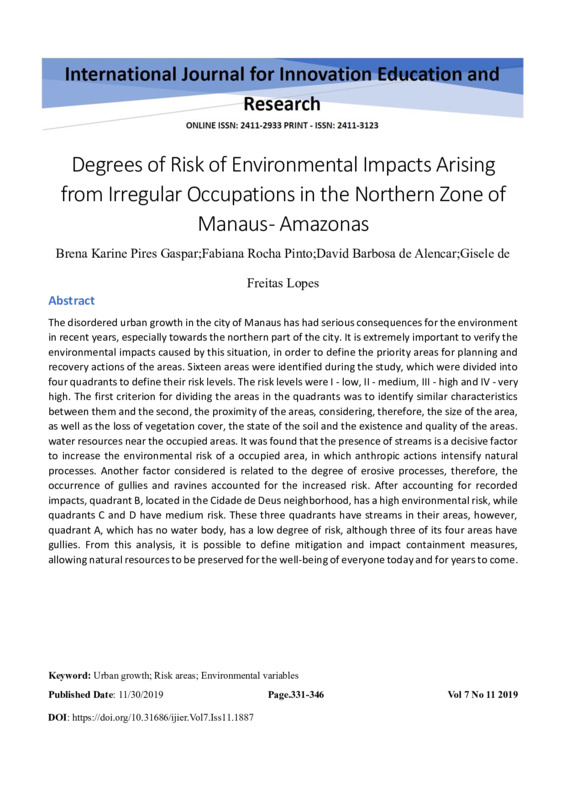-
Tipo do ITEM
-
Artigo Ciêntifico
-
Título do Artigo
-
Degrees of Risk of Environmental Impacts Arising from Irregular Occupations in the Northern Zone of Manaus - Amazonas
-
Descrição
-
Abstract
The disordered urban growth in the city of Manaus has had serious consequences for the environment
in recent years, especially towards the northern part of the city. It is extremely important to verify the
environmental impacts caused by this situation, in order to define the priority areas for planning and
recovery actions of the areas. Sixteen areas were identified during the study, which were divided into
four quadrants to define their risk levels. The risk levels were I - low, II - medium, III - high and IV - very
high. The first criterion for dividing the areas in the quadrants was to identify similar characteristics
between them and the second, the proximity of the areas, considering, therefore, the size of the area,
as well as the loss of vegetation cover, the state of the soil and the existence and quality of the areas.
water resources near the occupied areas. It was found that the presence of streams is a decisive factor
to increase the environmental risk of a occupied area, in which anthropic actions intensify natural
processes. Another factor considered is related to the degree of erosive processes, therefore, the
occurrence of gullies and ravines accounted for the increased risk. After accounting for recorded
impacts, quadrant B, located in the Cidade de Deus neighborhood, has a high environmental risk, while
quadrants C and D have medium risk. These three quadrants have streams in their areas, however,
quadrant A, which has no water body, has a low degree of risk, although three of its four areas have
gullies. From this analysis, it is possible to define mitigation and impact containment measures,
allowing natural resources to be preserved for the well-being of everyone today and for years to come.
Keyword: Urban growth; Risk areas; Environmental variables
-
Abstract
-
Abstract
The disordered urban growth in the city of Manaus has had serious consequences for the environment
in recent years, especially towards the northern part of the city. It is extremely important to verify the
environmental impacts caused by this situation, in order to define the priority areas for planning and
recovery actions of the areas. Sixteen areas were identified during the study, which were divided into
four quadrants to define their risk levels. The risk levels were I - low, II - medium, III - high and IV - very
high. The first criterion for dividing the areas in the quadrants was to identify similar characteristics
between them and the second, the proximity of the areas, considering, therefore, the size of the area,
as well as the loss of vegetation cover, the state of the soil and the existence and quality of the areas.
water resources near the occupied areas. It was found that the presence of streams is a decisive factor
to increase the environmental risk of a occupied area, in which anthropic actions intensify natural
processes. Another factor considered is related to the degree of erosive processes, therefore, the
occurrence of gullies and ravines accounted for the increased risk. After accounting for recorded
impacts, quadrant B, located in the Cidade de Deus neighborhood, has a high environmental risk, while
quadrants C and D have medium risk. These three quadrants have streams in their areas, however,
quadrant A, which has no water body, has a low degree of risk, although three of its four areas have
gullies. From this analysis, it is possible to define mitigation and impact containment measures,
allowing natural resources to be preserved for the well-being of everyone today and for years to come.
Keyword: Urban growth; Risk areas; Environmental variables
-
Língua do arquivo
-
inglês
-
Data da Publicação
-
Ano 2019
-
Palavra-chave
-
Urban growth
-
Risk areas
-
Environmental variables
-
Autores
-
Brena Karine Pires Gaspar
-
Fabiana Rocha Pinto
-
David Barbosa de Alencar
-
Gisele de Freitas Lopes
-
Local
-
ITEGAM - Manaus, 2019


